This site is available in multiple languages: Deutsch, Русский, عربي.
At Güntzplatz turn left onto Gerokstraße and continue down the right-hand side of the street until you reach the intersection of Marschnerstraße. Here you will find location no. 11 along the historical walking tour.
Before 1945: From exercises to experiments
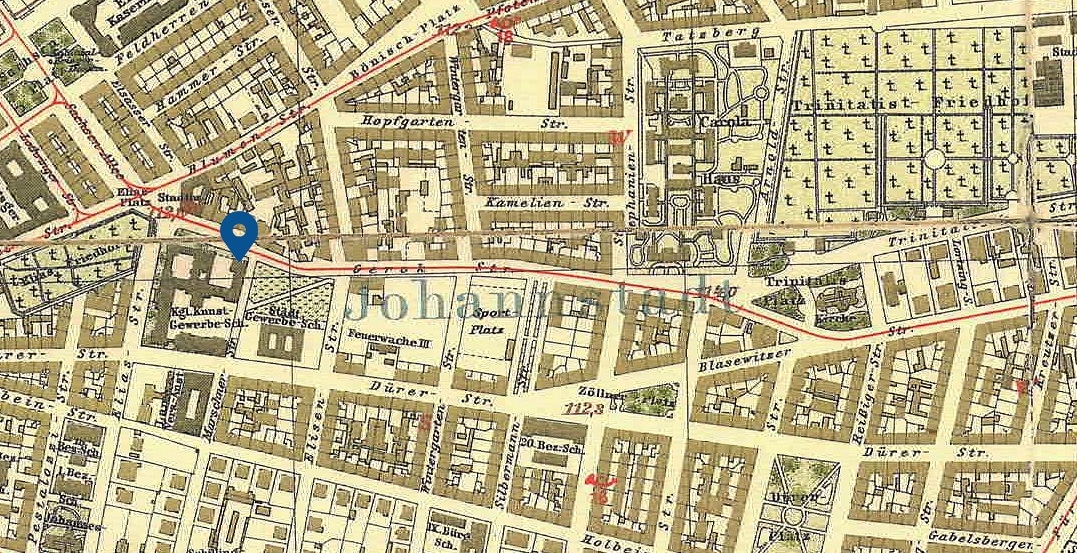
The disappearance of a parade ground
In the 19th century, the parade ground (military training ground) of the communal guard could be found in the space between today’s Gerokstraße, Dürerstraße and Güntzstraße. After 1841, the city made the area available to the “Vogelwiese” folk festival, which continued to be held here until its move to the Johannstadt Elbwiesen in the year 1873. In 1896, the Feuerwache III (fire station) became the first building to be erected on the former parade ground. From around 1914 to around 1933, the “Dresden Gymnastics Club 1867” used the remaining free space as summer training grounds.
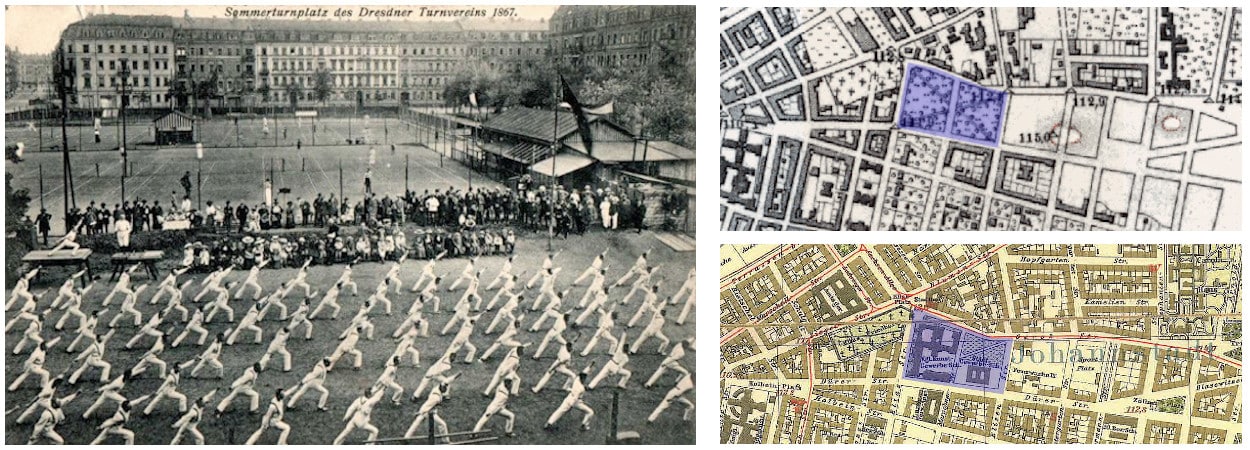
Right: The parade ground is developed bit by bit. The space is highlighted in blue on the map. Upper-right map from 1881. Lower-right map from 1911, Sources: SLUB Dresden / Deutsche Fotothek
Trade School
In 1901, construction of the Municipal Trade School was completed at Dürerstraße 45 (today the Evangelische Hochschule Dresden)), occupying a small piece of the land once belonging to the now-obsolete parade ground. The building was state-of-the-art and contained design halls and workshops for electrical engineers, precision engineers, mechanical engineers and carpenters. In 1925, the Vocational School for Plumbers, Electricians, Goldsmiths and Engravers was annexed. The school offered the training in day or night courses. In addition, the building had rooms for the schoolgirls’ section of the Dresden Club for Womens’ Training. In 1922, the school was renamed the “Dresden Municipal Trade and Technical Secondary School”. In 1920, an adjoining building expanded the premises to Gerokstraße and Elisenstraße (today Hans-Grundig-Straße).
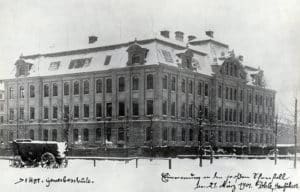
Sources: SLUB / Deutsche Fotothek
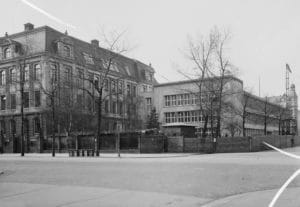
Find more information on the history of the Municipal Trade School and the later engineering college here.
School and museum of applied arts
In 1906, the new building for the School of Applied Arts and the Museum of the Applied Arts was erected on the corner of Gerokstraße and Eliasstraße, based on blueprints from architectural firm Lossow & Viehweger. The “Royal Saxon School of Applied Arts”—which in 1814 had grown out the art academy’s industrial school—came into full bloom starting in 1906 on Eliasstraße, changing its name to the “Academy of Applied Arts” after 1921. Professors such as Carl Rade (porcellan painting), Arno Drescher (applied graphics) and Margarete Junge (fashion)—who all felt a connection to the Deutscher Werkbund—laid the groundwork at the time for New Objectivity in Dresden. Among the most famous students were Otto Dix, Otto Griebel and Elfriede Lohse-Wächtler. The graduates Grete Wendt and Magarete Kühn would later go on to create their famous Christmas angel, which is still in production under the brand “Wendt & Kühn”. The building complex—belonging to the museum—represented the newest wave of museum architecture, with large halls and small galleries, some equipped with overhead lights. Pieces of the former Palais Brühl—which had been torn down in 1900 to make way for the Sächsisches Ständehaus on the Brühlsche Terrasse—were incorporated into the construction, including the Brühlscher Saal with its Rococo ceiling painting.
Find more information on the history of the School of Applied Arts here.
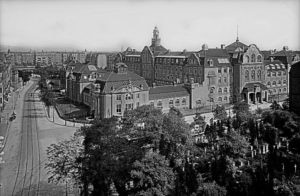
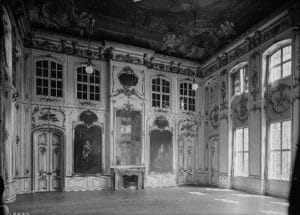
Source: SLUB Dresden / Deutsche Fotothek, W. Lossow
After 1945: Young art, few trees
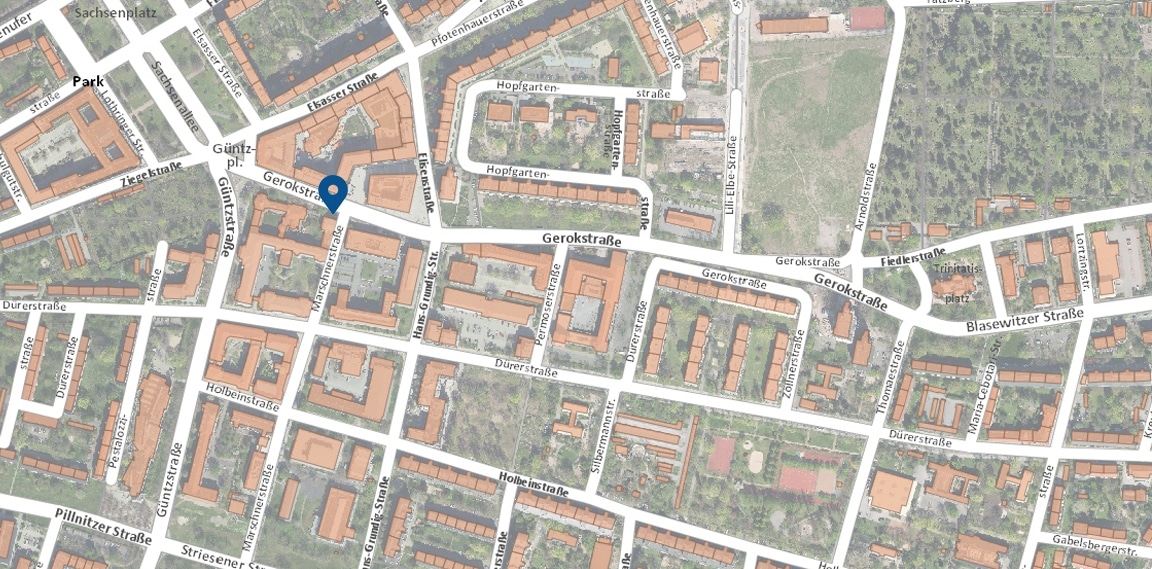
“We build up and tear down”
The aerial attacks of February 1945 damaged nearly all the buildings on Gerokstraße so badly that they needed to be demolished in the years that followed. Only one lightly-damaged part of the School of Applied Arts, as well as the reinforced concrete post office, the former “Horst-Wessel-Schule” (today, Gustav Anton Zeuner Vocational School Center) and the trade school had survived the heat of the fires and could be made useable again without too much work. From the early 1970s on, a distinctive 11-story residential building ran the length of Gerokstraße. After 50 years of use, this block of residences fell to a wrecking ball in 2013, making way for the construction of the new “Güntzareal”.
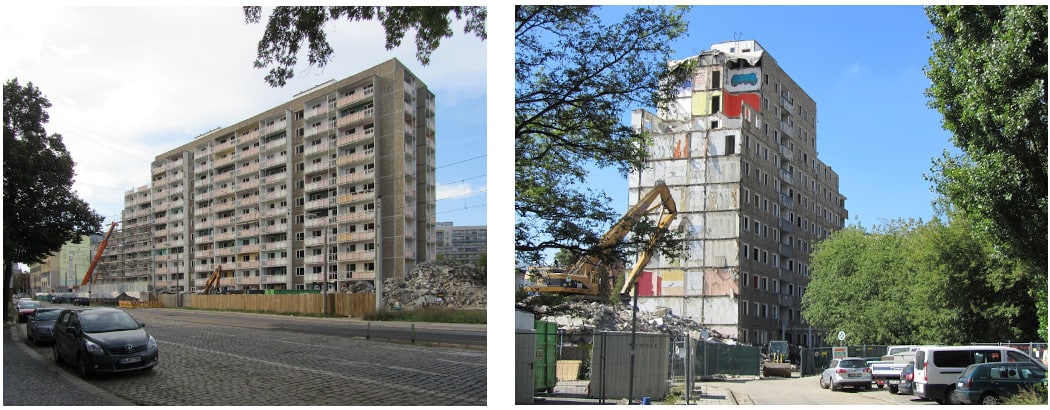
From trade school to Johannstadt campus
In the 1950s, technical schools for mecahnical engineering, electrical engineering and precision engineering—as well as an engineering school for aircraft manufacturing—moved into the building of the former trade school. In 1962, the entire organization became the Engineering School, named the Dresden College of Engineering in 1969. In 1965/66, the three fields of computer science enrolled more than 1,000 students. The school was merged with the TU Dresden in 1986, in order to concentrate the training of computer scientists in one location. The buildings of the former College of Engineering—completely renovated in 2007-2011—are today the home to the Staatliche Studienakademie Dresden, as well as the Evangelical College of Dresden.
From community college to an engraving and coin gallery to the HfBK
With the destruction of the main building of the School of Applied Arts also came the everlasting destruction of the Brühlschen Palais’s rococo hall. As early as 1952, the community college had opened the remaining parts of the building, offering a broad range of courses. When the Museum of Applied Arts moved into Schloss Pillnitz in 1963, the Coin and Engraving Collection—as well as the Central Library of the State Art Collection of Dresden moved into the free rooms. Ever since the entire installation moved into the completed Residenzschloss in the 2000s, the whole building has been used by the Academy of Fine Arts (HfBK). Here students can major in restoration, stage and costume design, theater equipment and art therapy. Among the highlights every year are public presentations, exhibitions and festivals, including the department of theater equipment’s yearly costume exhibition as part of the summer festival on Güntzstraße.
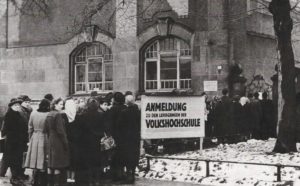
Redwoods
An unusual avenue can be seen on the east side of Hans-Grundig-Straße. It is none other than a test garden belonging to the Dresden Municipal Garden Authority, which decided toward the end of the 1980s to test the growth of the dawn redwood tree within the climate of the city. The trees were planted by students as part of their confirmation. The dawn redwood (latin: Metasequoia glyptostroboides) was first discovered in Japan in 1940, only as a fossil in layers of mud from the Tertiary Period. In 1941, the first living specimens were found by chance in a remote region of the Chinese province Szechuan, growing near a temple. The seeds of the dawn redwood tree arrived in Europe in 1947.
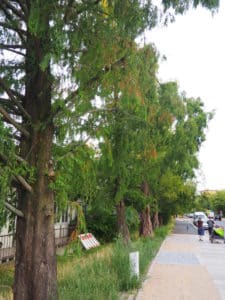
Text: Matthias Erfurth, Matthias Kunert, Henning Seidler
Editorial deadline: January 2024
